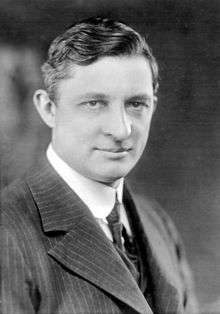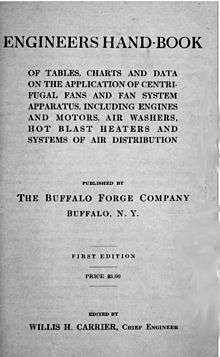Willis Carrier
| Willis Carrier | |
|---|---|
 Carrier in 1915 | |
| Born |
Willis Haviland Carrier November 26, 1876 Angola, New York |
| Died |
October 7, 1950 (aged 73)[1] New York City, New York, U.S. |
| Nationality | American |
| Alma mater | Cornell University (BS in engineering) |
| Occupation | Engineer, inventor |
| Known for | Inventing modern air conditioning |
| Awards | ASME Medal (1934) |
Willis Haviland Carrier (November 26, 1876 – October 7, 1950) was an American engineer, best known for inventing modern air conditioning. Carrier invented the first electrical air conditioning unit in 1902 and Carrier founded Carrier Corporation in 1915 a company specializing in the manufacturing and distribution of heating, ventilating, and air conditioning (HVAC) systems.
Early life and education
Carrier was born on November 26, 1876, in Angola, New York, the son of Duane Williams Carrier (1836–1908) and Elizabeth R. Haviland (1845–1888).
He studied at Cornell University graduating in 1901 with a BS in engineering.
Career

In Buffalo, New York, on July 17, 1902, in response to a quality problem experienced at the Sackett-Wilhelms Lithographing & Publishing Company of Brooklyn, Willis Carrier submitted drawings for what became recognized as the world's first modern air conditioning system. The 1902 installation marked the birth of air conditioning because of the addition of humidity control, which led to the recognition by authorities in the field that air conditioning must perform four basic functions:
- control temperature
- control humidity
- control air circulation and ventilation
- cleanse the air
After several more years of refinement and field testing, on January 2, 1906, Carrier was granted U.S. Patent 808,897 for an Apparatus for Treating Air, the world's first spray-type air conditioning equipment. It was designed to humidify or dehumidify air, heating water for the first and cooling it for the second.
In 1906 Carrier discovered that "constant dew-point depression provided practically constant relative humidity," which later became known among air conditioning engineers as the "law of constant dew-point depression." On this discovery he based the design of an automatic control system, for which he filed a patent claim on May 17, 1907. U.S. Patent 1,085,971 was issued on February 3, 1914.
On December 3, 1911, Carrier presented the perhaps most significant document ever prepared on air conditioning – Rational Psychrometric Formulae – at the annual meeting of the American Society of Mechanical Engineers. It became known as the "Magna Carta of Psychrometrics." This document tied together the concepts of relative humidity, absolute humidity, and dew-point temperature, thus making it possible to design air-conditioning systems to precisely fit the requirements at hand.
With the onset of World War I in late-1914, the Buffalo Forge Company, for which Carrier had been employed 12 years, decided to confine its activities entirely to manufacturing. The result was that seven young engineers pooled together their life savings of $32,600 to form the Carrier Engineering Corporation in New York on June 26, 1915. The seven were Carrier, J. Irvine Lyle, Edward T. Murphy, L. Logan Lewis, Ernest T. Lyle, Frank Sanna, Alfred E. Stacey, Jr., and Edmund P. Heckel. The company eventually settled on Frelinghuysen Avenue in Newark, New Jersey.
Despite the development of the centrifugal refrigeration machine and the commercial growth of air conditioning to cool buildings in the 1920s, the company ran into financial difficulties, as did many others, as a result of the Wall Street Crash in October 1929. In 1930, Carrier Engineering Corp. merged with Brunswick-Kroeschell Company and York Heating & Ventilating Corporation to form the Carrier Corporation, with Willis Carrier named Chairman of the Board.
Spread out over four cities in New Jersey and Pennsylvania, Carrier consolidated and moved his company to Syracuse, New York, in 1937, and the company became one of the largest employers in central New York.
Great Depression
The Great Depression slowed residential and commercial use of air conditioning. Willis Carrier's igloo in the 1939 New York World's Fair gave visitors a glimpse into the future of air conditioning, but before it became popular, World War II began. During the post-war economic boom of the 1950s, air conditioning began its tremendous growth in popularity. However, during the 1973 oil crisis, air conditioning went down in popularity as ceiling fans grew popular as an energy-saving alternative. Today however, air-conditioning and HVAC is a staple in many American homes, as well as homes in places like Hong Kong. Ceiling fans and air conditioning are often used in conjunction; in summer, a ceiling fan would save energy by allowing the thermostat to be set several degrees higher; in winter, they can be set to a low speed on reverse direction to bring down stratified heat from the heating system.
Legacy
In 1930, Carrier started Toyo Carrier and Samsung Applications in Japan and Korea. South Korea is now the largest producer for air conditioning in the world. The Carrier Corporation pioneered the design and manufacture of refrigeration machines to cool large spaces. By increasing industrial production in the summer months, air conditioning revolutionized American life. The introduction of residential air conditioning in the 1920s helped start the great migration to the Sunbelt. The company became a subsidiary of United Technologies Corporation in 1980. The Carrier Corporation remains a world leader in commercial and residential HVAC and refrigeration. In 2007, the Carrier Corporation had sales of more than $15 billion and employed some 45,000 people.
Personal life
Carrier and all three of his wives (Claire Seymour, d. 1912; Jennie Martin, d. 1939; Elizabeth Marsh Wise, d. 1964) are buried in Forest Lawn Cemetery in Buffalo, New York.[2] Despite being married three times, Willis Carrier never fathered any children himself.
Carrier was a Presbyterian.[3][4]
Awards and recognition
For his contributions to science and industry, Willis Carrier was awarded an engineering degree by Lehigh University in 1935[5] and an honorary Doctor of Letters degree by Alfred (NY) University in 1942; Carrier was awarded the Frank P. Brown Medal in 1942; and was inducted posthumously in the National Inventors Hall of Fame (1985) and the Buffalo Science Museum Hall of Fame (2008).
References
- ↑ Margaret Ingels, Willis Haviland Carrier: father of air conditioning, Country Life Press, 1952, p. 101: "Willis Haviland Carrier died in New York on October 7, 1950, shortly before his seventy-fourth birthday."
- ↑ Ingels, Margaret (1952), Willis Haviland Carrier: Father of Air Conditioning, Garden City: Country Life Press.
- ↑ Willis Carrier
- ↑ People of the Century, Willis Carrier p.64:"Willis Carrier, who read and sought out knowledge until his death at 73, married three times (twice a widower) and adopted two children, neither of whom survive. In classic American-businessman fashion, he was a Presbyterian, a Republican and a golfer."
- ↑ Cornelius, Billy (1946), The Lehigh Story (PDF), Bethlehem: Self Published, p. 95.